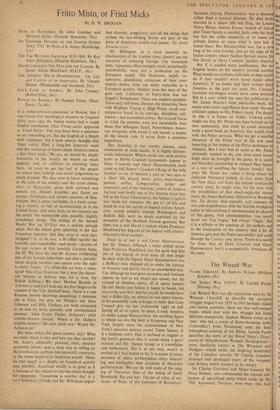The Wizard War
DIE SECRET WAR 1939-45. By Gerald Pawle. (Harrap, 18s.) ftlE Wizard War was the expression used by Sir Winston Churchill to describe the ceaseless struggle waged from 1939 to 1945 between Allied and enemy scientists. Here are two well-written books which deal with this struggle but from different standpoints. Andrew Wilson writes as a 'user' who led a troop of flame-throwing tanks ('crocodiles') from Normandy until the final triumphant crossing of the Rhine. Gerald Pawle describes the work of the Royal Navy's Direc- torate of Miscellaneous Weapon Development— more familiarly known as The Wheelers and Dodgers—which under the inspiring leadership of the Canadian scientist Sir Charles Goodeve invented and developed many of the weapons and devices which assisted us to victory.
Sir Charles Goodeve and Major-General Sir Percy Hobart, who commanded the curious col- lection of specialised tanks which made up the 79th Armoured Division. were men who had much in common; a ruthless determination to get Things done, a complete disregard for Whitehall's red tape, and the ability to inspire their subor- dinates with their own zeal. Andrew Wilson certainly considered his 'crocodiles' to be war- Winning weapons and, when evacuated to England with wounds, spared no effort to get back to his troop. It is when writing about his experi- ences as a troop leader that he is at his best.
Gerald Pawle's canvas is broader and he writes at greater length. Many of the inventions he describes will be news to most readers since they have until now been shrouded in secrecy. So per- haps will be his account of the distinguished part played by Nevil Shute, the novelist, in the Wizard War. Some of the devices described rival Heath Robinson in conception. One such was the 'Great Panjandrum' which consisted of two enormous steel wheels, each ten feet in diameter, connected by an axle filled with high explosive. This was to be launched against the enemy shore from a land- ing craft, and would be driven at a speed of sixty miles per hour by means of rockets fitted to the circumference of each wheel. Like some vast Catherine wheel it would thunder up the beach until exploding with devastating effect against the enemy's concrete defences. Whether the 'Great Panjandrum' qualified to be a Wheeze or a Dodge is hard to say, but it is easy to understand how Sir Charles Goodeve's brilliant team sometimes found it hard to sell their ideas to the more con- servative-minded members of the Admiralty.
JAMES LUNT















































 Previous page
Previous page